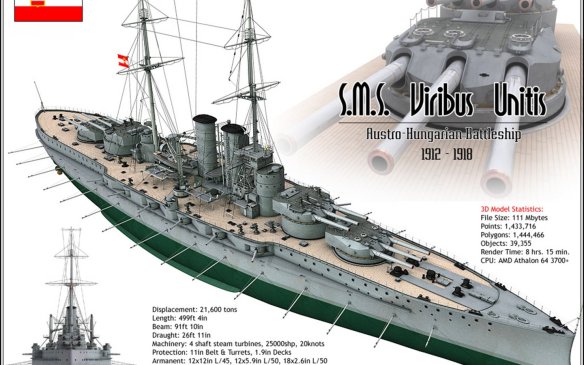In the last twenty years of its existence the Imperial and Royal Navy ‘flew the flag’ on more than 85 so-called ‘Missionsreisen’ of which 34 were to Eastern Asia. Notwithstanding huge arguments over financing and budgets, the navy underwent significant modernisation. The determination to be the leading naval power of the Adriatic in the face of rising Italian competition became a strategic imperative. To the relatively modest ‘Monarch’ class of capital ships were added the ‘Habsburg’, ‘Radetzky’ and ‘Erzherzog Karl’ classes, which enjoyed significantly increased armour and gunnery.
The ‘Monarch’ class, like the older ‘Aspern’ and ‘Kaiserin und Königin Maria Theresa’ which had seen service in China, were light cruisers with crews of barely 450. They had been designed with coastal duties along the Adriatic in mind though they were to be used not only as far afield as China, but as supports for civilian evacuation during the Spanish-American War off Cuba, and during the Crete crisis of 1897–98 as well.
The ‘Radetzky’ and ‘Habsburg’ classes took the navy to another level. At 8,232, tons the ‘Habsburg’ represented a significant increase in size and were the first battleships which could be considered truly ‘ocean-going’. This ambitious naval programme fell victim to the annual feuding over naval budgets between the Austrian and Hungarian parliaments. The Hungarians saw little value to the Hungarian taxpayer in supporting a programme of ship construction which took place in Trieste, a key city of the Austrian part of the Empire. Admiral Spaun resorted to many wiles to get his naval estimates approved but in 1904 the ever-fractious politicians successfully moved a reduction in the naval budget of 50 per cent, and Spaun resigned. Spaun’s replacement, Rudolf Montecuccoli, renewed the struggle with the politicians. Supported by the Archduke Franz Ferdinand, he succeeded in winning approval for the next class, the ‘Radetzky’, which resembled the British ‘King Edward VII’ class, having a main armament of four 30.5cm guns laid out in twin turrets. When the ‘Radetzky’ turned up at the Coronation Naval Review at Spithead in 1911 it was praised for its sharp lines and very comfortable officers’ quarters. With a crew of nearly 900 officers and men it demonstrated how far the Imperial and Royal Navy had come in less than a dozen years.
The later ‘Tegetthoff’ class of ‘Dreadnoughts’ (all big-gun ships, named after HMS Dreadnought launched in 1906, the first ship to enjoy uniform battery armament) were designed by the renowned ship’s architect Siegfried Popper. Popper had been born in Prague in 1848. Overseeing in the late 1860s the construction of more modest Austrian warships at the Armstrong works in Newcastle, he became friends with the chief naval architect of the British Royal Navy, Sir William White, who was much impressed by Popper’s brilliance and superior calculative ability. Popper’s friendship with White meant that he was kept fully abreast of English innovations in the projected ‘Dreadnought’ class. His own ‘Tegettfhoff’-class ‘Dreadnoughts’ would come to be considered some of the most impressive warships of their class anywhere in the world and famously were the first ships ever to have been constructed with triple 30.5cm-gun turrets.
Once again, infighting among the politicians led to skilful ruses to secure funding on the part of the navy. Montecuccoli had announced on 20 February 1909 that Austria would be building a new generation of battleship, of nearly 19,000 tons displacement, to head off Italy’s proposed construction of a ‘Dreadnought’ rival. When the politicians balked at the expenditure, Montecuccoli persuaded both the Triestine shipyard and the Skoda armaments factory to begin work on construction at their own risk while the Admiral whipped up a public relations campaign involving virtually every powerful figure in the Empire from the Emperor downwards.
Construction was approved on credit and the politicians left to rubber-stamp the process when their bickering died down. When the STT shipyard in Trieste voiced objections, Montecuccoli literally drew out of his pocket a personal cheque written on his account for 32 million crowns (about £12 million in today’s money). Work began on the first two ships: the Viribus Unitis and the Tegetthoff. The Hungarians eventually agreed to support the programme on condition that one ship was given a Hungarian name, the Szent István (St Stephen, Hungary’s patron saint) and constructed in the Hungarian port of Fiume (Rijeka).
The Viribus Unitis, commissioned in 1912, contained many features that were innovative in the design of battleships, notably with regard to its radiotelegraphy systems. A particularly interesting feature of the design was the main armament of twelve 30.5cm guns, carried in four triple turrets, arranged in two superimposed pairs fore and aft on the centre line. Like all Austrian mountings, these were electrically driven and could elevate to 20 degrees, firing a 450 kilogram shell capable of penetrating 47cm of armour up to three miles away. Popper’s design weaknesses, sadly only too soon to reveal themselves, were confined to the retention of the ‘mine bottom’ whose space between hull and bulkhead would in the event of a torpedo hit be too small for the resultant expanding gases.
As the great crisis of 1914 approached, the Dual Monarchy could take some comfort in the fact that it possessed a significant naval force, greater in tonnage than its Italian rival. In addition, a naval air arm began to take form from 1910. It would prove itself more than equal to the challenges ahead. The heir to the Imperial throne, Archduke Franz Ferdinand expressed some satisfaction in the way his personal interests had prevailed with the development of the fleet. But in the army, the situation was less happy. A number of crises came to focus the Archduke’s attention on shortcomings and weaknesses. Coupled with wider strategic disagreements, the relationship between Thronfolger (heir) and General Staff would be stretched to breaking point.
